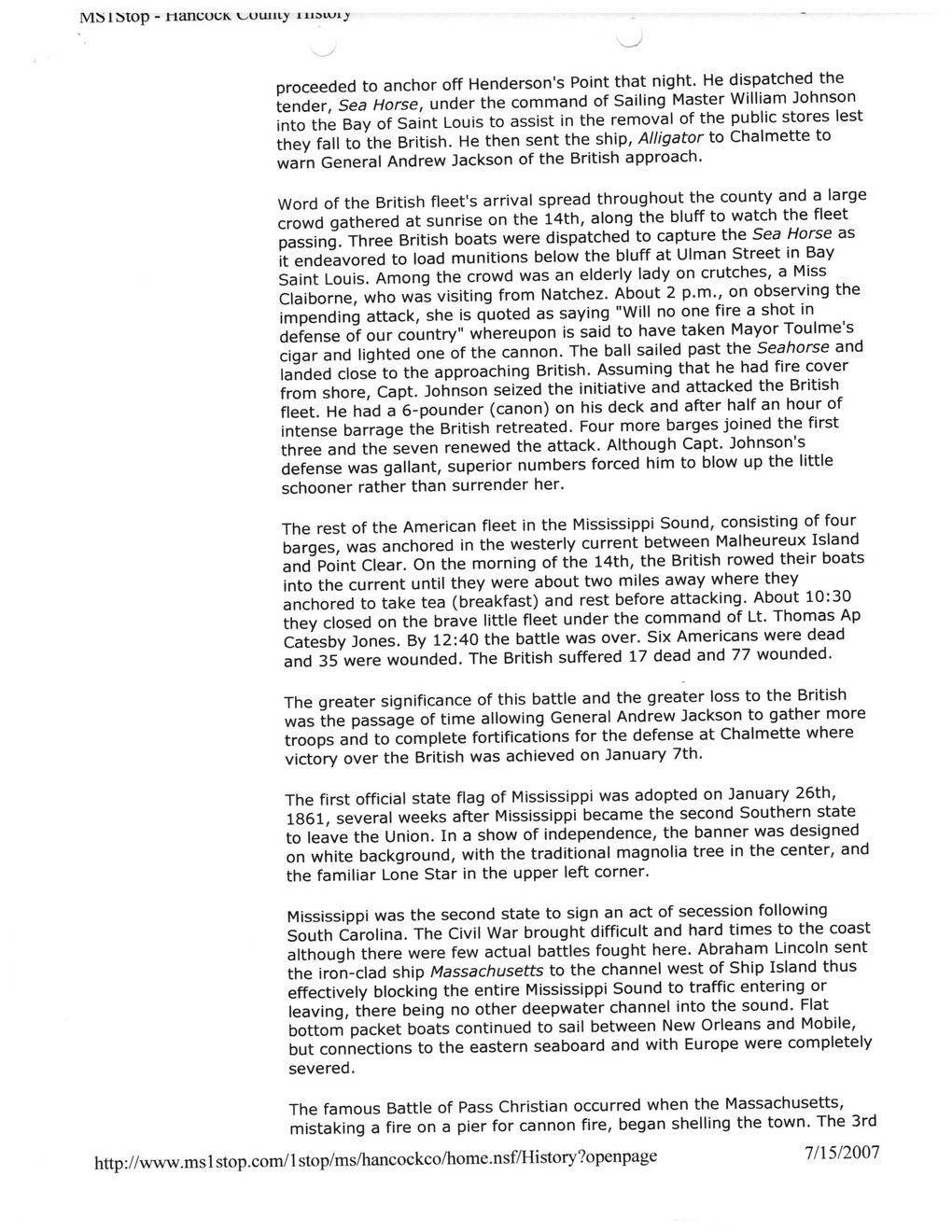This text was obtained via automated optical character recognition.
It has not been edited and may therefore contain several errors.
MSI Slop - fiancocK v^uuin^ msiuij proceeded to anchor off Henderson's Point that night. He dispatched the tender, Sea Horse, under the command of Sailing Master William Johnson into the Bay of Saint Louis to assist in the removal of the public stores lest they fall to the British. He then sent the ship, Alligator to Chalmette to warn General Andrew Jackson of the British approach. Word of the British fleet's arrival spread throughout the county and a large crowd gathered at sunrise on the 14th, along the bluff to watch the fleet passing. Three British boats were dispatched to capture the Sea Horse as it endeavored to load munitions below the bluff at Ulman Street in Bay Saint Louis. Among the crowd was an elderly lady on crutches, a Miss Claiborne, who was visiting from Natchez. About 2 p.m., on observing the impending attack, she is quoted as saying "Will no one fire a shot in defense of our country” whereupon is said to have taken Mayor Toulme's cigar and lighted one of the cannon. The ball sailed past the Seahorse and landed close to the approaching British. Assuming that he had fire cover from shore, Capt. Johnson seized the initiative and attacked the British fleet. He had a 6-pounder (canon) on his deck and after half an hour of intense barrage the British retreated. Four more barges joined the first three and the seven renewed the attack. Although Capt. Johnson's defense was gallant, superior numbers forced him to blow up the little schooner rather than surrender her. The rest of the American fleet in the Mississippi Sound, consisting of four barges, was anchored in the westerly current between Malheureux Island and Point Clear. On the morning of the 14th, the British rowed their boats into the current until they were about two miles away where they anchored to take tea (breakfast) and rest before attacking. About 10:30 they closed on the brave little fleet under the command of Lt. Thomas Ap Catesby Jones. By 12:40 the battle was over. Six Americans were dead and 35 were wounded. The British suffered 17 dead and 77 wounded. The greater significance of this battle and the greater loss to the British was the passage of time allowing General Andrew Jackson to gather more troops and to complete fortifications for the defense at Chalmette where victory over the British was achieved on January 7th. The first official state flag of Mississippi was adopted on January 26th, 1861, several weeks after Mississippi became the second Southern state to leave the Union. In a show of independence, the banner was designed on white background, with the traditional magnolia tree in the center, and the familiar Lone Star in the upper left corner. Mississippi was the second state to sign an act of secession following South Carolina. The Civil War brought difficult and hard times to the coast although there were few actual battles fought here. Abraham Lincoln sent the iron-clad ship Massachusetts to the channel west of Ship Island thus effectively blocking the entire Mississippi Sound to traffic entering or leaving, there being no other deepwater channel into the sound. Flat bottom packet boats continued to sail between New Orleans and Mobile, but connections to the eastern seaboard and with Europe were completely severed. The famous Battle of Pass Christian occurred when the Massachusetts, mistaking a fire on a pier for cannon fire, began shelling the town. The 3rd http://www.msl stop.com/1 stop/ms/hancockco/home.nsf/History?openpage 7/15/2007

Hancock County A-Touch-of-History-(7)